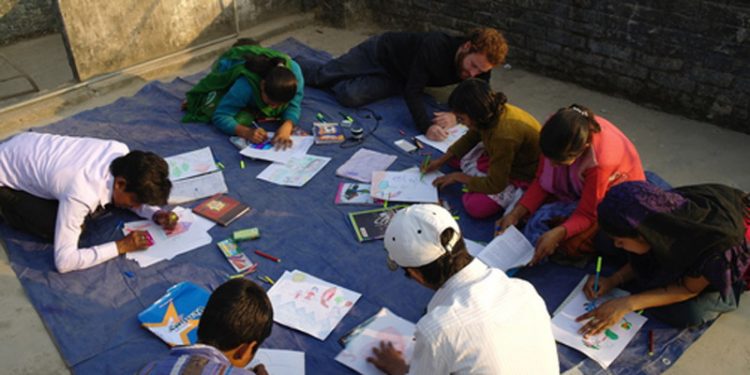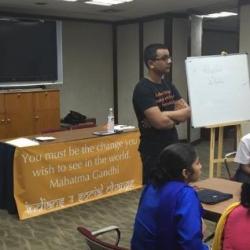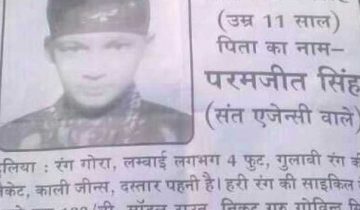We Refused to Tell People in This Bihar Village That They Need Help. It Worked Wonders.

There’s a village called Dom Tola in Kishanganj district, Bihar, where Project Potential, the NGO I founded, is working. The Dom caste is responsible for cleaning up trash, dealing with dead humans and animals, and cleaning human waste. Meanwhile, while walking, I always encounter black, hairy pigs rolling in their own feces. The area is a flood zone, so children cannot reach their school.
There’s a village called Dom Tola in Kishanganj District, Bihar, where Project Potential, the NGO I founded, is working. The first person I meet whenever I go to Dom Tola is Tuntun Malik, whose firm handshake and white, toothy smile always gives me hope. Meanwhile, at Tuntun’s house, his mother and some of the neighbours are shaving slivers of bamboo stalks that they then weave into dust pans, fans, and other products. No matter what their economic struggles, they always insist that I take tea and snacks.
Both stories are true, and yet, the story we choose to tell has profound implications on how we understand and therefore interact with Dom Tola. The first seeks only to diagnose problems, and looks at a place at a moment in time. The second acknowledges challenges, but also seeks to tell the narrative with respect to the strengths of people in the village.
If we choose to tell only the first story, then the solutions we carve out will exclude the people in Dom Tola, since they will be seen as victims in need of saving. If we tell the second story, then it will be acknowledged while an outside catalyst may spur more development, our biggest resource in the process of creating change is the people themselves.
In the longer-term, the method we choose affects the community’s self-identity and understanding of their own capacities. If we choose the first story and method, then the community will internalize its helplessness; on the other hand, if we choose the second, then the community will become more resilient and growth itself will become more sustainable.
In Project Potential’s eyes, the second story is more valid. Everyone, no matter what age, religion, or caste, has some strength of head, heart, or hand that can be leveraged to reach shared goals. Our core competency is in identifying the right local people—we call them Village Visionaries—who can mobilize their communities to look beyond differences to work together for a better future.
In Dom Tola, we chose to tell the second story. Village Visionary Razia Sultana used Tuntun as an entry point into the village to start building relationships and trust. Spending time at each house, she began mapping physical assets and individual strengths of people in the village. Based on these assets and the goals professed by people in the village, Razia founded a women’s association.
The main goals that the women mentioned were to increase their own education, to educate their children, and to increase their income. From her asset mapping, Razia knew exactly who the literate people in the community were, so she trained a local girl with an 8th grade education to teach the women basic literacy.
The local school was inaccessible due to rain. So Razia used the village’s biggest strength—its numbers—to organize a meeting with local government. The result? A school was opened in a local community member’s house in the short-term and a commitment was made by the district magistrate to create a proper drainage system there once the rains stop.
Finally, in terms of economic empowerment, Razia has helped the women connect to larger markets so that they can use their skill to earn more money from their bamboo products. She also taught and helped them get job cards so that they are now guaranteed up to 100 days of work via the Indian government’s MNREGA scheme.
Why did these developments not happen organically? One reason is that community members may lack the right relationships, connections, and knowledge. They may not have connections to these larger markets, and they may also not know about how to avail government schemes. Not having this knowledge, they may have tried and failed in the past, which may prevent people from trying again.
Yet, I’d argue that a reason that is just as important, if not more so, is the story that is told about a place. People in Dom Tola have been told the first story mentioned above by government, other NGOs, and the community at large: “You are poor Dom caste people, and therefore you need help.” As a result, the community begins suffering from what psychologists call “learned helplessness,” where they may not even take advantage of available opportunities, feeling that nothing will be able to change their situation.
On the other hand, when an organization or catalyst fundamentally believes that everyone, even those who are currently suffering, brings something to the table, then the outcome is completely different. People begin using their strengths in concert with one another to bring about a better shared future.
The result? People working together to achieve their goals using existing resources. When the resources within the community are insufficient, then they have the bargaining power and the right relationships needed to work with service providers who can meet their needs.
The next time you engage in a community development project, do not start by asking the community what’s wrong with their lives. Instead, start by asking what’s right and how that can be leveraged for change.




